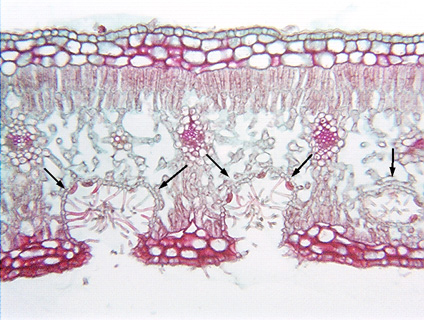 Fig.
10.3-10. Transverse section of oleander leaf (Nerium
oleander). Oleander leaves are a favorite in plant anatomy laboratories
because they demonstrate a placement of stomata that has ecological
significance. The arrows indicate three
stomatal crypts: the crypts are large chambers in the mesophyll,
covered with an epidermis that contains stomata as well as trichomes (hairs)
that project into the crypt. The epidermis on the exposed surface of the leaf
– between crypts – lacks stomata. The narrow opening between the crypt and
the atmosphere, combined with the presence of trichomes, causes the air inside
the crypt to be rather immobile, even if there is a strong wind blowing over the
leaf. Any water molecule that diffuses out of a stomatal pore will spend so much
time that there is a high probability it will diffuse back into one of the
stomata in the crypt. See following figures for higher magnifications.
Fig.
10.3-10. Transverse section of oleander leaf (Nerium
oleander). Oleander leaves are a favorite in plant anatomy laboratories
because they demonstrate a placement of stomata that has ecological
significance. The arrows indicate three
stomatal crypts: the crypts are large chambers in the mesophyll,
covered with an epidermis that contains stomata as well as trichomes (hairs)
that project into the crypt. The epidermis on the exposed surface of the leaf
– between crypts – lacks stomata. The narrow opening between the crypt and
the atmosphere, combined with the presence of trichomes, causes the air inside
the crypt to be rather immobile, even if there is a strong wind blowing over the
leaf. Any water molecule that diffuses out of a stomatal pore will spend so much
time that there is a high probability it will diffuse back into one of the
stomata in the crypt. See following figures for higher magnifications.